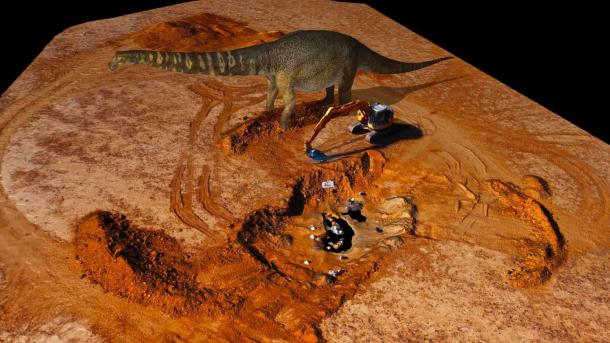Australotitan cooperensis , nicknamed Cooper, was the largest dinosaur species to have walked the ancient land of Australia, a new study in the PeerJ journal has revealed. This giant sauropod, unnamed and unidentified since its discovery between 2005 and 2007, was between 25-30 meters (82-98 feet) long, 5 and 6.5 meters (16.4-21.3 feet) tall, and weighed between 23 and 74 tons (20,800- 67,100 kilograms), the equivalent of 1400 red kangaroos in weight and as long as a basketball court!
“Australotitan cooperensis adds to the growing list of uniquely Australian dinosaur species discovered in Outback Queensland, and just as importantly showcases a totally new area for dinosaur discovery in Australia,” said Dr. Scott Hocknull, a researcher at the Queensland Museum and the University of Melbourne, who was the lead author on the study .

A reconstructed model of Cooper, Australia’s largest dinosaur, shown next to a big piece of construction equipment. ( Eromanga Natural History Museum )
Discovery and Analysis of Cooper, Australia’s Largest Dinosaur
Australia’s largest dinosaur is part of the Titanosauria dinosaur class, which were the last surviving group of long-necked plant-eating sauropods, until they went extinct at the end of the Cretaceous period . The Titanosauria group was a diverse one, with species ranging from the largest known terrestrial vertebrates to dwarf dinosaurs no bigger than elephants, according to Sci News . They roamed the Australian landmass between 92-96 million years ago.
Cooper’s fossilized skeleton was found in the southern-central Winton Formation of the Eromanga Basin, a Mesozoic sedimentary basin in northern Australia. This specific discovery was in the Queensland portion of the Eromanga basin, next to Cooper Creek, from where the name of the new dinosaur species is derived.
A reconstruction of the osteological remains and limb-size comparisons using 3D surface scan modelling, led to a comparative understanding of the appendicular skeleton between the Australian finds and their South American counterparts, who were found to be slightly larger.
The Daily Mail reports that dinosaur bones are typically large, heavy and fragile, and carefully preserved in museums thousands of kilometers apart, making comparisons between dinosaur fossils challenging. Fortunately, modern technology is rife with possibilities that help bridge this distance, especially through the use of 3D scans . “The 3D scans we created allowed me to carry around 1000s of kilos dinosaur bones in a 7kg laptop. Better yet, we can now share these scans and knowledge online with the world,” said Dr. Hocknull.
“To make sure Australotitan was a different species, we needed to compare its bones to the bones of other species from Queensland and globally. This was a very long and painstaking task,” added Dr. Hocknull. He was joined by other archaeologists and paleontologists from Queensland Museum and the Eromanga Natural History Museum, who’ve been cooperating on this study for the last 17 years.
Three other Australian sauropods were closely related to Cooper. The other species were from the north, near Winton and were part of a larger family that seemingly co-existed peacefully or may have never met. “We found that Australotitan was the largest in the family, followed by Wintonotitan with big hips and long legs, whilst the two smaller sauropods, Diamantinasaurus and Savannasaurus were shorter in stature and heavily-set.”

From dig to digital dinosaurs! 3D scanning technology provided researchers with an unprecedented way to compare fossilized bones of enormous dinosaurs and view these digital replicas virtually. (S. Hocknull & R. Lawrence / Queensland Museum )
Australia’s Largest Dinosaur and Its Continental Cousins
Cooper was similar to its South American and Asian counterparts, suggesting a dispersal from South America via Antarctica during periods of global warmth, or island hopping across the archipelagos which are geographically the present-day terrains of Southeast Asia and the Philippines.
Yet, the challenge in Australia, specifically in Queensland’s outback, is that dinosaur sites are “featureless plains,” unlike sites where mountain ranges and deep canyons expose “ancient layers of preserved fossilized bones,” the archaeology team wrote in The Conversation .
“Over the last 17-years numerous dinosaur skeletons have been found, including one with an almost complete tail. The discovery of a rock-shelf, almost 100 metres long, represents a sauropod pathway, where the dinosaurs walked along trampling mud and bones into the soft ground,” Dr Hocknull said. “Discoveries like this are just the tip of the iceberg. Our ultimate goal is to find the evidence that tells the changing story of Queensland, hundreds of millions of years in the making. A grand story all scientists, museums and tourists can get behind.”
The discovery of this dinosaur fossil is one of many that has been made in Australia in recent decades due to painstaking efforts taken by local communities and governments, working in cooperation with paleontologists and archaeologists.
This is what Queensland Museum CEO Dr. Jim Thompson describes as “a dinosaur rush”, who calls Queensland the “palaeo-capital” of Australia. They also see it as a huge boost to creating local jobs and tourism opportunities moving forward.
Top image: Australotitan cooperensis is the new species confirmed by paleontologists in Australia. It is the largest dinosaur ever discovered in Australia. Source: Vlad Konstantinov and Scott Hocknull / Eromanga Natural History Museum
By Rudra Bhushan
 RSS Feed
RSS Feed















 June 10th, 2021
June 10th, 2021  Awake Goy
Awake Goy  Posted in
Posted in  Tags:
Tags: 













